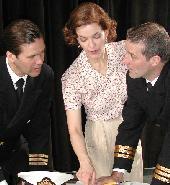SEARCH CurtainUp
REVIEWS
FEATURES
NEWS (Etcetera)
LISTINGS
Broadway
Off-Broadway
BOOKS and CDs
OTHER PLACES
Berkshires
London
Los Angeles
Philadelphia
Elsewhere
QUOTES
On TKTS
LETTERS TO EDITOR
FILM
LINKS
MISCELLANEOUS
Free Updates
Masthead
NYC Weather
The Flashing Stream
By Macey Levin
|
Mathematics is one of the ways of being…of loving.
|

Steve Groff, Jennifer Dorr White and L.J.
Ganser
(Photo: Alexander Rupert ) |
Confined to a secluded island in the Atlantic, Commander Edward Ferrers of the British Royal Navy and four colleagues are developing a top-secret weapon that he believes will bring him world-wide acclaim as the savior of the human race. While three of the group are career navy men, one of the task force is Karen Selby, a young civilian woman who has been forced into the group by Walter Harowby, MP. Her involvement, of course, triggers conflict and romance, both of which could prove devastating to the project.
The weapon, an experimental "aerial torpedo," is similar to today's heat seeking missiles that can destroy an enemy plane or warhead while in flight. Sixty-five years ago this technology was in its infancy and not an element of general awareness. Morgan's creation and projected utilization of such a weapon, probably based on some insider knowledge, is very sophisticated.
The script is one of those British stiff-upper-lip-let-us-be-noble dramas that were popular during the 1930's and 40's. The dialogue is somewhat dated and several of the plot twists are predictable. The discussions and plot elements based on the weapon's development often constitute compelling theatre, but there are irrelevant sub-plots that dilute the work. Morgan weaves several romantic relationships through the play, some of which are ludicrous and do not greatly enhance the central plot. Even the relationship between Ferrers and Selby takes bizarre turns. But this is a component of the genre. Despite the script problems the production moves fairly well and is far from tedious.
The staging and acting fall into the same stodginess and superficiality as the script. Director Miranda D' Ancona's major problem is in the blocking of those scenes which utilize more than three or four people. Often the actors are placed in clumps or straight lines creating ineffectual stage pictures. Movement, including entrances, exits and one poorly staged tussle that is supposed to be a fight, are awkward and false. Still, this does not inflict great harm on the telling of the story.
The cast has inconsistent performances. Ferrers is a man whose dedication to his task brings him to the edge of sanity. As played by L.J. Ganser, the closer his approach to this precipice, the more melodramatic he becomes. He rolls his eyes, utters guttural laughs, gnashes his teeth and has mercurial changes in attitude. Fortunately, he does refrain from wringing his hands and slobbering.
Jennifer Dorr White, whose father is an eminent mathematician, is a controlled Karen Selby whose failing struggle to keep her emotions in check elicits a certain amount of empathy. Though she is described as "a flame" White's Selby carries a very cool demeanor, another directorial misstep.
Commander Henry Carr, Ferrers' supportive second-in-command, is in the hands of Davis Hall whose stoic carriage masks great strength and a greater loyalty. It is a nicely nuanced performance. Steve Groff and Cameron Francis, as the other two researchers, are satisfactory though they sometimes over-act.
Jerry Browning's set is well-detailed using a muted palette with a splash of bougainvillea red as seen through upstage doors leading to a terrace. Placement of furniture, however, helps create some of the awkward staging. The costumes by Elly Van Horne are authentic recreations of 1930's wardrobe and British uniforms.
The production, despite its weaknesses, continually holds one's attention. This may be ascribed to the contemporary relevance of the major plot. Revivals of seldom performed works should be welcomed, but the play should be worth reviving for its entirety, not merely its key element.
|
THE FLASHING STREAM Written by Charles Morgan Directed by Miranda d'Ancona Cast: Michael Bastock, Glynis Bell, Stephen Bradbury, Cameron Francis, L.J. Ganser, Scott Glascock, Steve Groff, Davis Hall, Robert Sonderskov, Jennifer Dorr White Scenic Design: Jerry Browning Lighting Design: John Michael Deegan Costume Design: Elly Van Horne Original Music: Jonathan Faiman Running time: 2 hours, 25 minutes (one intermission) Theatre 3, 311 West 43rd St. Previews: 4/1-4/16; opens: 4/17; closes 5/11 Tues-Sat at 8pm; Sat. at 2pm; Sun at 3pm--$45, 212-279-4200 or www.ticketcentral.com Reviewed by Macey Levin at 4/15 performance |

Mendes at the Donmar
Our Review

At This Theater

Leonard Maltin's 2003 Movie and Video Guide

Ridiculous!The Theatrical Life & Times of Charles Ludlam

Somewhere For Me, a Biography of Richard Rodgers

The New York Times Book of Broadway: On the Aisle for the Unforgettable Plays of the Last Century

6, 500 Comparative Phrases including 800 Shakespearean Metaphors by CurtainUp's editor.
Click image to buy.
Go here for details and larger image.



